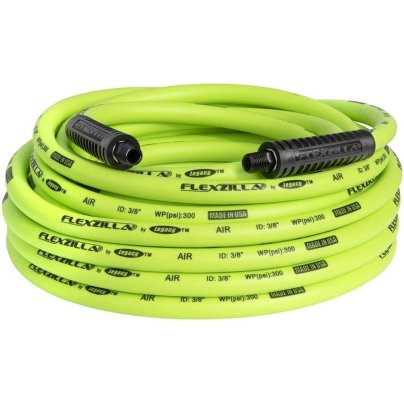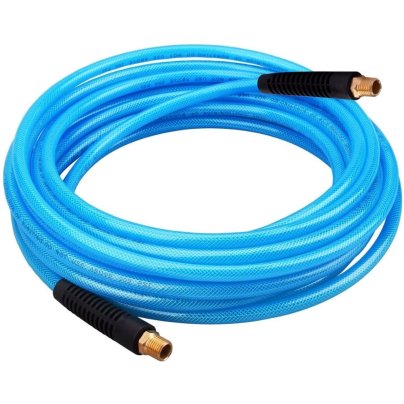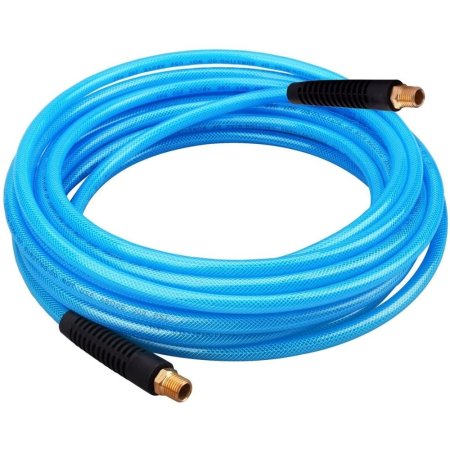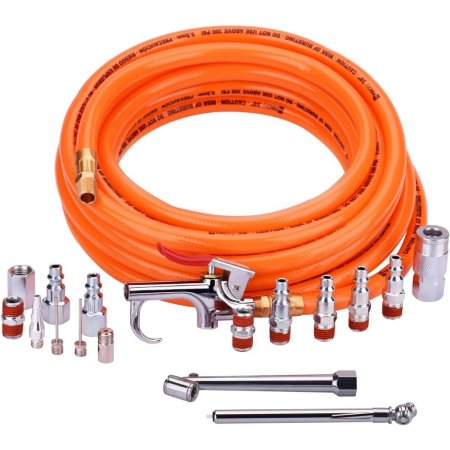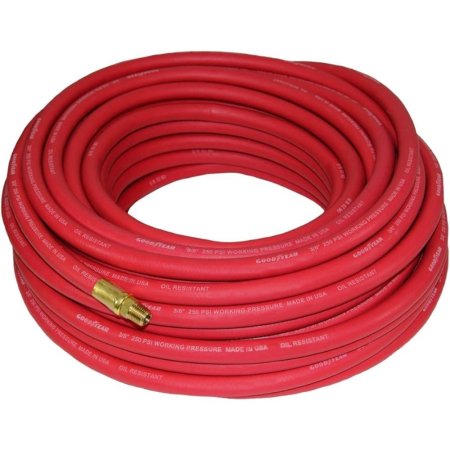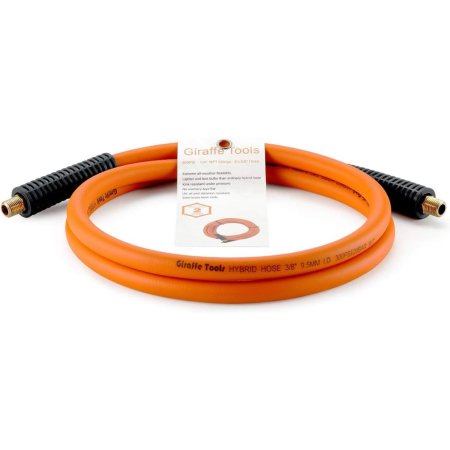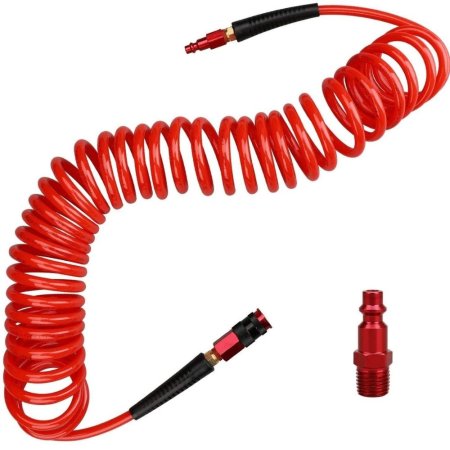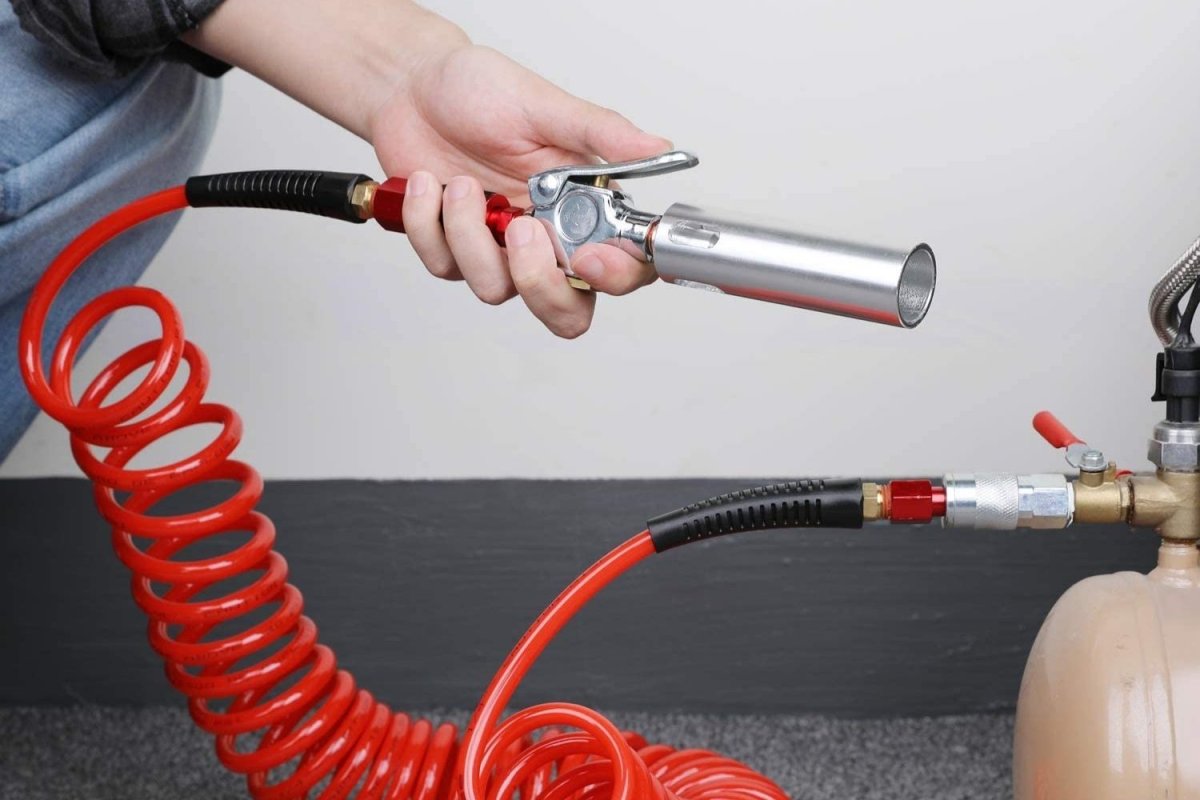
We may earn revenue from the products available on this page and participate in affiliate programs. Learn More ›
An air compressor is a valuable asset in any workshop. For jobs as varied as fixing a deflated tire to building a shed frame, an air compressor makes the work easier. Even so, an air compressor is only as good as its hose, and choosing the right one can be confusing. Air compressor hoses come in a variety of materials and sizes, each suited to fit a different budget and to perform various applications.
This guide untangles the world of air compressor hoses by identifying which factors to consider before shopping. Read on to find out how to find the best air compressor hose for the job.
- BEST OVERALL: Flexzilla ⅜-Inch 50-Foot Air Hose
- BEST BANG FOR THE BUCK: Wynnsky ¼-Inch 25-Foot Polyurethane Hose
- UPGRADE PICK: Wynnsky ⅜-Inch 25-Foot PVC Air Compressor Hose
- BEST RUBBER: Goodyear ⅜-Inch 50-Foot Red Rubber Air Hose
- BEST HYBRID: Giraffe Tools Hybrid ⅜-Inch 50-Foot Air Hose
- BEST RECOIL: Hromee ¼-Inch 25-Foot Polyurethane Recoil Air Hose
- BEST POLYURETHANE: Sanfu Polyurethane Reinforced ¼-Inch ID Air Hose
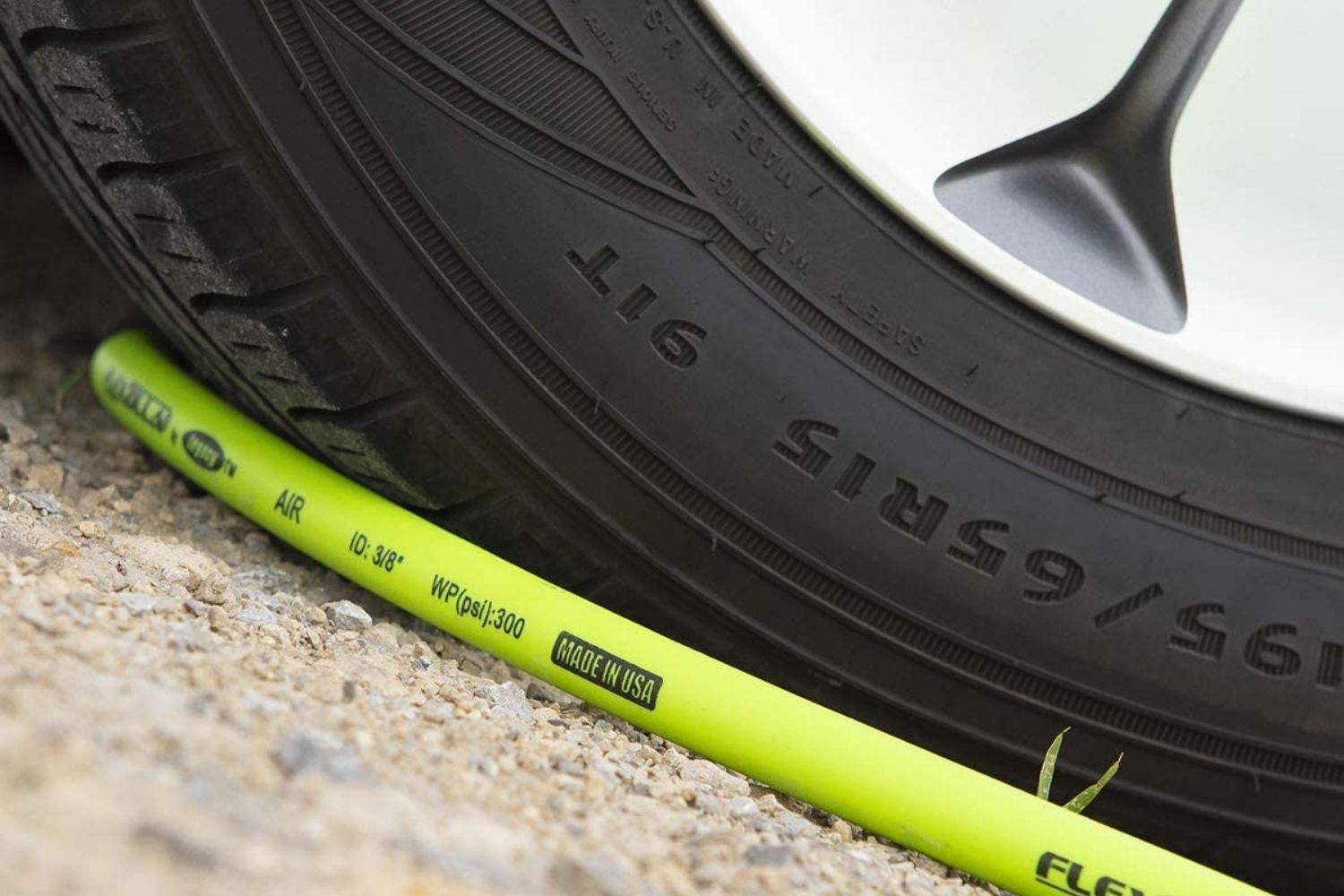
How We Chose the Best Air Compressor Hoses
When selecting the air compressor hoses for this list, we considered many important factors brought to our attention by expert John Lin, a professional mechanic and co-founder of JB Motor Works in Philadelphia, Pennsylvania.
Lin advises that shoppers prioritize material when choosing an air compressor hose based on their needs: “Rubber hoses remain flexible even in cold weather, which is a plus if you’re working in a cooler garage or outdoors. Whereas PVC hoses can be stiffer, especially in the cold, polyurethane hoses, though usually more expensive, are light and strong.” As such, we were sure to include rubber, hybrid, and polyurethane options to suit multiple users’ preferences and withstand high and low temperatures.
Another thing we considered while selecting the best air compressor hoses was the length, which is why we included multiple options varying from 25 to 50 feet. When selecting an appropriate length, Lin suggests that shoppers “consider their workspace as longer hoses give you a larger working area, but shorter hoses provide more air pressure at the tool end.” A hose’s ability to coil for storage, lie flat, and resist kinking also plays a vital role in its ease of use, so hoses with superior flexibility ranked high on our list.
A quality air compressor hose should also be able to handle being dragged around a rugged work environment, so durability was also a priority when making our selections. We took the maximum pressure and bursting pressure of each hose into account, with our list of options able to handle 120 to 300 pounds per square inch (PSI). (For more information on PSI, read the section Pressure Rating that appears after our product reviews.)
With these core attributes in mind, we researched dozens of different hoses from various brands to select the top models on the market.
Our Top Picks
Air compressor hoses are great pneumatic tools for various projects, including painting, tire maintenance, and more. The following hoses are well constructed, easy to work with, and suit various budgets.
Best Overall
Flexzilla ⅜-Inch 50-Foot Air Hose
Pros
- Made with hybrid polymer and aluminum fittings; resists kinks and provides ample durability
- Lightweight enough to be moved or transported; will not cause any strain on the user
- High maximum working pressure of 300 PSI (at 70 degrees Fahrenheit)
Cons
- Pricier than other ⅜-inch 50-foot hoses available today
- Quick connectors not included; may not be ideal for some users’ preferences
Product Specs
- Materials: Hybrid polymer with anodized aluminum ends
- Weight: 5 pounds
- Pressure rating: 300 PSI
A good air hose shouldn’t work against the operator by kinking and coiling. This air compressor hose from Flexzilla features a hybrid construction that makes it flexible even in temperatures above 140 degrees Fahrenheit or below -40 degrees Fahrenheit.
Weighing just 5 pounds, this hose is light enough to haul up a ladder or lug around a roof. The hose comprises a hybrid polymer that resists kinking, coils easily, and has zero memory—even if it’s been coiled up in storage for months. With a max pressure of 300 PSI, the Flexzilla air hose is suitable for tough jobs.
Get the Flexzilla air compressor hose at Amazon.
Best Bang for the Buck
Wynnsky ¼-Inch 25-Foot Polyurethane Hose
Pros
- Polyurethane construction resists tangles and kinks while in use or being stored
- Lightweight and easy to maneuver; one of the lightest options on this list
- Brass fittings create tight seals and resist corrosion for long-term use and durability
Cons
- Smaller diameter than other hoses; may take a little longer than some comparable options
- Not as durable as rubber models on the market
- Shorter 25-foot length may not be ideal for some users’ preferences
Product Specs
- Materials: Polyurethane
- Weight: 1.1 pounds
- Pressure rating: 300 PSI
Wynnsky’s ¼-inch hose is a good option for those looking for an affordable hose that’s easy to work with. Polyurethane construction and bend restrictors at the ends resist kinks while enduring up to 300 PSI of pressure.
Wynnsky outfits its products with brass fittings, which better resist corrosion than standard aluminum fittings. And, at just over 1 pound, this lightweight hose is easy to maneuver. However, with a ¼-inch internal diameter, its cubic feet per minute (CFM) is lower than a larger ⅜-inch hose.
Get the Wynnsky ¼-inch air compressor hose at Amazon.
Upgrade Pick
Wynnsky ⅜-Inch 25-Foot PVC Air Compressor Hose
Pros
- Kink-resistant, heavy-duty PVC construction with an abrasion-resistant cover
- Comes with a 17-piece kit of accessories for a wide range of applications
- Made with solid brass fittings to easily connect attachments, use after use
Cons
- Some users have reported leaking from time to time
Product Specs
- Materials: PVC and solid brass
- Weight: 2.9 pounds
- Pressure rating: 300 PSI
Made for general purpose applications, the Wynnsky ⅜-inch 25-foot PVC air compressor hose has everything required to maintain tires, paint, and other uses. This option has a lightweight, kink-resistant design with an internal diameter of ⅜ inch. It is made with heavy-duty PVC and a nonmarring abrasion-resistant cover for long-term effective use.
However, the best part of this option may be the 17-piece kit that includes all the necessary attachments for a wide range of applications, including a tire chuck, tire gauge, air blow gun, blow gun safety nozzle, and more. This model can withstand up to 300 PSI of pressure and has solid brass fittings, which are more durable than other materials such as aluminum, steel, or zinc.
Get the Wynnsky ⅜–inch air compressor hose at Amazon or Walmart.
Best Rubber
Goodyear ⅜-Inch 50-Foot Red Rubber Air Hose
Pros
- Made with strong rubber, solid brass NPT fittings, and spiral synthetic yarn for excellent durability
- Can be used for both air and water applications; suitable for air compressors, staple guns, brad nailers, and more
- Construction can withstand temperatures of -40 to 190 degrees Fahrenheit
Cons
- Much heavier than some comparable options on the market
Product Specs
- Materials: EPDM rubber and solid brass NPT
- Weight: 7 pounds
- Pressure rating: 250 PSI
Those looking for convenience, versatility, and long-term use will want to consider this Goodyear option. The 50-foot hose is made with strong ethylene propylene diene monomer (EPDM) rubber, solid brass National Pipe Taper (NPT) fittings, and spiral synthetic yarn, making it one of the most durable options on this list.
This durable air hose can withstand 250 PSI and has a kink-resistant construction. This option can be used for air and water applications for added versatility. It can withstand cold weather conditions of -40 degrees Fahrenheit and high heat of up to 190 degrees Fahrenheit.
Get the Goodyear air compressor hose at The Home Depot or Walmart.
Best Hybrid
Giraffe Tools Hybrid ⅜-Inch 50-Foot Air Hose
Pros
- Kink- and tangle-free hybrid construction for ease of use and storage
- High max working pressure of 300 PSI for a wide variety of applications
- Lightweight at about 5 pounds; should be easy to move while in use without causing strain
Cons
- Not as “memory-free” as a pure rubber hose, making it hard to coil
- Pricier than other hybrid hoses on the market
Product Specs
- Materials: Rubber/PVC
- Weight: 5.1 pounds
- Pressure rating: 300 PSI
This hybrid hose from Giraffe offers a performance similar to that of a high-end rubber hose, but at a more affordable price. The ⅜-inch hose comprises a PVC and rubber hybrid material. Bend restrictors at either end of the hose help prevent kinking and tangling.
With a high max working pressure of 300 PSI and burst pressure of 1,200 PSI, this hose is ideal for tougher applications, such as air drills and ratchets. The outer coating resists oil and harmful UV rays. At 5 pounds, it’s one of the lightest ⅜-inch 50-foot hoses on the market.
Get the Giraffe Tools air compressor hose at Amazon.
Best Recoil
Hromee ¼-Inch 25-Foot Polyurethane Recoil Air Hose
Pros
- Recoils from a max length of 25 feet to 18 inches for ease of storing after use
- Flexible polyurethane construction resists kinking and tangling
- Universal coupling is compatible with different types of fittings
Cons
- Pressure rating of 120 PSI; cannot withstand the pressure of some other models
- Narrower ¼-inch diameter; offers less CFM
Product Specs
- Materials: Polyurethane
- Weight: 1.2 pounds
- Pressure rating: 120 PSI
Quality construction and design make this air hose a quality option for those who like the convenience of a recoil air hose. This ¼-inch self-coiling hose measures 18 inches long when coiled and extends to a max length of 25 feet. It features a polyurethane construction that retains its flexibility even in extreme cold.
Bend restrictors resist kinking while also adding durability to the hose, while a smooth finish resists oil, abrasion, and grease. Hromee also includes a universal coupler with this hose that fits industrial, ARO, and automotive plugs.
Get the Hromee air compressor hose at Amazon.
Best Polyurethane
Sanfu Polyurethane Reinforced ¼-Inch ID Air Hose
Pros
- Working pressure of 300 PSI; can be used for light- to heavy-duty applications
- The brass fittings integrated can rotate 360 degrees for ease of use
- Quick-connect adapter included for added convenience and versatility
Cons
- Not as flexible as rubber; may be a little too stiff for some users
- ¼-inch diameter produces less airflow than larger-diameter hoses
Product Specs
- Materials: Polyurethane
- Weight: 2.4 pounds
- Pressure rating: 300 PSI
Design features that improve the durability of this Sanfu hose while making it easier to use put this model among the top polyurethane air hoses on the market. It consists of a layer of polyurethane with interwoven braided thread, creating a double layer that can handle a working pressure of 300 PSI and a bursting pressure of 900 PSI. At 2.5 pounds, it’s still lightweight.
Sturdy brass fittings rotate 360 degrees, while bend restrictors prevent kinks at the ends, making the hose easier to work with. The hose also includes a quick connect coupler, an add-on that eliminates the need to purchase and install one separately.
Get the Sanfu air compressor hose at Amazon.
Jump to Our Top Picks
What to Consider When Choosing an Air Compressor Hose
In addition to material type, the hose’s length, diameter, connector style, and kink resistance are important factors to consider when buying a new air compressor hose. Keep reading to find out why these factors make a difference.
Types of Air Compressor Hoses
While rubber reigns supreme as the main component in air compressor hoses, this material isn’t the right choice for every air compressor. Learn about the different hose types to determine which is a better choice based on function and affordability.
Rubber
Rubber compressor air hoses are the most common and readily available type of air compressor hose. These hoses, which consist of synthetic rubber reinforced with either braided or spiraled yarn, are heavy and durable. They rarely leak and are fairly easy to fix if they do.
Rubber hoses are easy to work with because they don’t kink and they coil easily—even in extreme temperatures. Because rubber is a tacky material, however, it does tend to collect a lot of dirt when dragged across a garage floor. Rubber hoses also are more expensive than other types of air hoses.
Hybrid
Hybrid hoses are made of a blend of rubber, polyurethane, and PVC. This powerful combination gives them qualities similar to a rubber hose at a lighter weight, making a hybrid hose easier to work with. Moreover, hybrid hoses aren’t as tacky as rubber, which means they don’t collect as much dirt.
Hybrid air compressor hoses are very durable, but they can kink after extended use. Their light weight and flexibility make hybrid air compressor hoses ideal for all types of tasks, whether used in a garage or atop a 15-foot ladder.
PVC
PVC air hoses, the most affordable air compressor hoses on the market, consist of a PVC-compound inner tube and a polyester spiral outer. Because PVC hoses are stiffer than rubber hoses, they’re somewhat difficult to coil and uncoil.
PVC hoses usually hold their shape, making them difficult if not impossible to lie flat. They can kink and become inflexible in colder temperatures. These qualities make PVC hoses, which are often included free with air compressors, difficult to work with, prompting many DIYers to upgrade to a different material.
Polyurethane
Polyurethane hoses are similar in appearance to PVC but perform much better. They’re light and flexible, and their smooth outer layer allows them to glide easily across almost any surface.
These qualities make them a good choice for working with pneumatic roofing or framing nailers, jobs in which both freedom of movement and distribution of weight are critical. Polyurethane hoses aren’t as flexible as rubber hoses, making them susceptible to kinking. Next to rubber, polyurethane hoses are one of the more expensive types of air compressor hoses.
Nylon
Nylon hoses are lightweight and easy to coil, and they’re priced at a fraction of the cost of rubber hoses. The problem with nylon, however, is that it kinks easily and isn’t particularly durable. Nylon hoses have significantly lower max pressure (typically around 100 PSI) than other materials, making them suitable for lighter-duty applications, such as powering a pneumatic staple gun or finish nailer.
Hose Length
The length of the hose determines which applications the hose can be used for and how much pressure it can handle. Air compressor hoses generally come in lengths ranging from 6 to 50 feet.
Longer hoses are required for framing, roofing, painting, and other projects in which the user must be able to travel some distance from the air compressor. Hose length (along with internal diameter) determines how much pressure an air compressor can deliver. The longer the hose, the more the pressure will drop as it moves from compressor to attachment.
Shorter hoses are a good choice for applications that demand higher pressures and sustained use, such as filling a large truck tire, for example. However, longer hoses are better suited for short and powerful bursts of air, such as when using a framing nailer.
Hose Diameter
The diameter of an air compressor hose determines how much air the hose is capable of delivering. Hoses come in diameters ranging from 0.2 to 0.5 inches or ¼ inch to ½ inch. The right one for the job depends on the size of the air compressor.
An air compressor is rated as to how much air it can deliver per cubic feet per minute. A compressor with a low CFM should use a smaller-diameter air compressor hose, while a compressor with a high CFM should use a larger-diameter hose. The most common size air hose is a ⅜-inch hose.
Connectors
Compressor hoses have threaded ends that allow the user to attach quick-release connectors to them. Quick-release connectors let the user switch between different power tools. Quick-release connectors come in ¼-inch, ⅛-inch, and ½-inch sizes to accommodate the size of the hose and the corresponding tool attachment. Connectors are manufactured from aluminum and brass. Brass is superior to aluminum because it better resists wear and corrosion and creates a tighter connection.
Pressure Rating
All air compressor hoses have a max pressure rating, which indicates the PSI of pressure the hose can withstand without breaking. Most manufacturers list both the max working pressure and the burst pressure. The working pressure is the maximum PSI the hose can handle for an extended period, while burst pressure is the maximum amount of pressure that a hose can withstand before breaking.
A hose with a higher PSI rating can handle tougher jobs, such as inflating a car tire. Higher PSI hoses will also last longer. Most air compressor hoses have a working PSI rating between 200 and 300 PSI with a burst pressure that is four times that amount.
Coiling Capability
Air compressor hoses coil via one of two methods: standard or recoil. A standard hose lies flat with no coils or bends, making it easy to unroll and stretch flat for maximum length or to coil for storage. Recoil hoses feature small twists in the hose that cause it to recoil backward when the user lets go of it.
Recoil hoses are ideal for working around a garage or workshop, as a hose can create a tripping hazard or get in the way. The hose has enough length to use for inflating tires or painting but automatically retracts, so it’s out of the way when not in use. Standard hoses, in comparison, lie flat and have a longer maximum length—making them an ideal choice for operating a nailer.
Kink Resistance and Twisting
Similar to a garden hose, air compressor hoses can twist and kink as they’re being pulled and uncoiled, which causes a delay in airflow. These kinks can cause inconvenient lapses in air pressure at the end of the hose or cause the hose to burst at the kink. Rubber hoses resist kinking better than any other type. Though they’re not as kink resistant as rubber, hybrid and polyurethane hoses also resist kinking and twisting; PVC and nylon hoses kink fairly easily in comparison.
Temperature Compatibility
Also consider an air hose’s ability to resist changes to its flexibility in different temperatures. Rubber hoses, for example, maintain their flexibility in temperatures as low as -40 degrees Fahrenheit. Polyurethane and rubber hoses retain their flexibility even in frigid temperatures, whereas PVC (and even hybrid hoses) become less flexible and harder to work with when the thermometer drops.
Tips for Using an Air Compressor Hose
While the quality of an air compressor hose is critical to its performance, using and caring for it properly help you get the biggest bang for your buck. The connections between the hose, compressor, and attachments are key, so keep the couplers clean of dirt and debris, which can cause leaks or clog the hose. In hot and humid conditions, consider purchasing a filter attachment that goes between the hose and the compressor to remove condensation from the hose and prevent mist from spraying out of tool attachments.
Hoses can get heavy when working at a height. Eliminate some of the load by hanging the hose on a hook or scaffolding. Safety is also crucial when using an air compressor hose. Uncoupling a hose at pressure can cause it to flail dangerously as the air releases. Prevent this from happening by installing a safety coupler that depressurizes the hose before release.
Here’s a quick recap on how to use an air compressor hose:
- Keep hose ends free of dirt and debris.
- Add a filter attachment to keep water out of the lines in humid conditions.
- Hang heavy hoses on a hook or scaffolding.
- Prevent flailing hoses with a safety coupler.
FAQs
If you still have questions about how each element impacts an air compressor or which size hose will work with your compressor, then keep reading for the answers to these and other commonly asked questions.
Q. Can a damaged air hose cause an air compressor not to work?
A damaged air hose cannot damage an air compressor; however, it can hurt the performance of the compressor by preventing the maximum amount of air pressure from being delivered to the tool at the end of the hose.
Q. Which size hose should I use for my air compressor?
The size of the air hose involves both the tool you’ll be using and the air compressor itself, as different tools require different amounts of airflow. Nailers and staple guns that require a small intermittent burst of air work with a ¼-inch hose. Tools that require sustained air pressure, such as a pneumatic ratchet or tire inflator, require a larger ¾-inch hose. You’ll also need an air compressor that produces enough CFM to work with the hose.
Q. Can frost damage an air hose?
While frost won’t damage an air hose’s material, freezing temperatures can cause the moisture inside the hose to freeze, creating blockages that may impact its performance.
Q. What is the best air hose for cold weather?
Cold weather can make a hose stiff and difficult to work with. Rubber hoses are the best option for cold weather as rubber remains flexible even in extreme cold.
Q. Are compressor hoses universal?
Air compressor hoses are universal in their ability to connect air compressors and tools. However, tools fit couplers in various sizes: ¼ inch, ⅛ inch, ½ inch, 1 inch.
Q. How do I attach a quick air hose?
To attach a quick air hose to a compressor, pull back the collar on the female coupler on the compressor. Push the male end of the hose into the compressor’s coupler; then pull the collar forward to lock it in. The process is the same when connecting attachments at the other end of the hose.
Q. Do air hose fittings need Teflon tape?
Though not required, it’s a good idea to use Teflon tape on the threads of the hose fittings before attaching them. The Teflon tape helps create an airtight connection between the hose and fitting.
